Age-Related Changes in the Composition of Gut Bifidobacterium Species
- PMID: 28593350
- PMCID: PMC5486783
- DOI: 10.1007/s00284-017-1272-4
Age-Related Changes in the Composition of Gut Bifidobacterium Species
Abstract
Bifidobacteria are one of the major components in human microbiota that are suggested to function in maintaining human health. The colonization and cell number of Bifidobacterium species in human intestine vary with ageing. However, sequential changes of Bifidobacterium species ranging from newborns to centenarians remain unresolved. Here, we investigated the gut compositional changes of Bifidobacterium species over a wide range of ages. Faecal samples of 441 healthy Japanese subjects between the ages of 0 and 104 years were analysed using real-time PCR with species-specific primers. B. longum group was widely detected from newborns to centenarians, with the highest detection rate. B. breve was detected in approximately 70% of children under 3 years old. B. adolescentis and B. catenulatum groups were predominant after weaning. B. bifidum was detected at almost all ages. The detection rate of B. dentium was higher in the elderly than in other ages. B. animalis ssp. lactis was detected in 11.4% of the subjects and their ages were restricted. B. gallinarum goup was detected in only nine subjects, while B. minimum and B. mongoliense were undetected at any age. The presence of certain Bifidobacterium groups was associated with significantly higher numbers of other Bifidobacterium species/subspecies. Inter-species correlations were found among each species, exception for B. animalis ssp. lactis. These results revealed the patterns and transition points with respect to compositional changes of Bifidobacterium species that occur with ageing, and the findings indicate that there may be symbiotic associations between some of these species in the gut microbiota.
Conflict of interest statement
Conflict of interest
Kumiko Kato, Toshitaka Odamaki, Eri Mitsuyama, Hirosuke Sugahara and Jin-zhong Xiao were employed by Morinaga Milk Industry Co., Ltd.
Ethical Approval
All procedures performed in studies involving human participants were in accordance with the ethical standards of the institutional and/or national research committee and with the 1964 Helsinki Declaration and its later amendments or comparable ethical standards.
Informed Consent
Informed consent was obtained from all individual participants included in the study.
Figures




References
MeSH terms
LinkOut - more resources
Full Text Sources
Other Literature Sources
Medical
Research Materials

